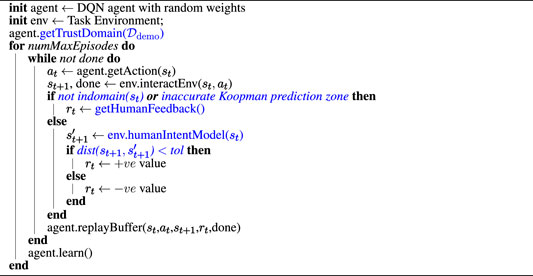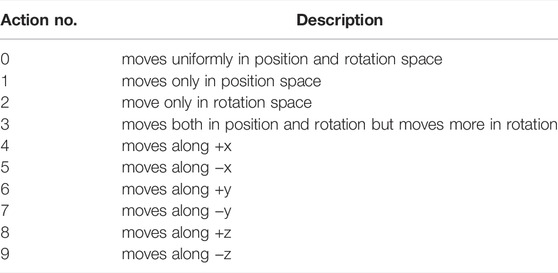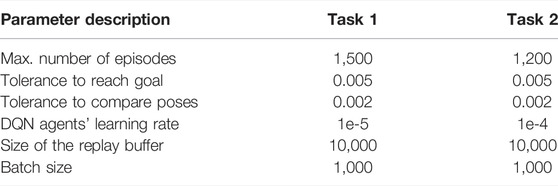Koopman Operator–Based Knowledge-Guided Reinforcement Learning for Safe Human–Robot Interaction
- Mechanical Engineering Department, Clemson University, Clemson, SC, United States
We developed a novel framework for deep reinforcement learning (DRL) algorithms in task constrained path generation problems of robotic manipulators leveraging human demonstrated trajectories. The main contribution of this article is to design a reward function that can be used with generic reinforcement learning algorithms by utilizing the Koopman operator theory to build a human intent model from the human demonstrated trajectories. In order to ensure that the developed reward function produces the correct reward, the demonstrated trajectories are further used to create a trust domain within which the Koopman operator–based human intent prediction is considered. Otherwise, the proposed algorithm asks for human feedback to receive rewards. The designed reward function is incorporated inside the deep Q-learning (DQN) framework, which results in a modified DQN algorithm. The effectiveness of the proposed learning algorithm is demonstrated using a simulated robotic arm to learn the paths for constrained end-effector motion and considering the safety of the human in the surroundings of the robot.
1 Introduction
In robot motion planning, we are interested in finding a path from the start to the goal such that at all the intermediate points, the robot is collision free. Motion planning for robots has a rich literature and has been very successful (LaValle, 2006). In imitation learning (IL) Schaal (1999), the robot path is generated by utilizing human demonstrated trajectories, which have been proven to be effective for generating paths for complex tasks. The use of reinforcement learning (RL), along with the demonstrated data, has emerged effective as it allows the optimal policy to be learned by interacting with the planning environments (Finn et al., 2016). However, one of the major challenges with this approach is obtaining the appropriate reward function for the RL agent. Furthermore, the demonstrated data used in these algorithms are expected to contain rich observation data. These algorithms are often computationally expensive and take a long time to learn the optimal trajectories.
In this article, we propose a novel knowledge-guided deep reinforcement learning (DRL) framework to learn path planning from human demonstrated motion. The Koopman operator is used to develop the representation of human intent from the demonstrated trajectories for some tasks, which are then used to design the reward function of the RL-based autonomous planning agent. During the learning phase of the DRL agent, at each step, the state achieved by the agent after taking an action is compared to the human-preferred state predicted by the Koopman model of human intent to decide the reward that the DRL agent would receive. However, the Koopman operator model of the human intent would only be effective in the domain where the demonstrated data points are available, resulting in wrong or ambiguous state prediction of the human intent, which makes designing the appropriate reward function challenging. In order to alleviate this issue, the demonstrated trajectories are further used to generate a trust region in which the Koopman model prediction can be relied upon to provide the DRL agent an appropriate reward. To the best of our knowledge, we are the first to use the Koopman operator to design the reward function for the DRL agent. The reason Koopman operator is effective in modeling nonlinear data is that it uses several nonlinear basis functions to capture the underlying nonlinear behavior of the data unlike the linear regression model. Figure 1 outlines the end-to-end workflow of learning to plan a path from demonstrated trajectories by an RL agent utilizing the Koopman operator–based human intent model to design the reward function.
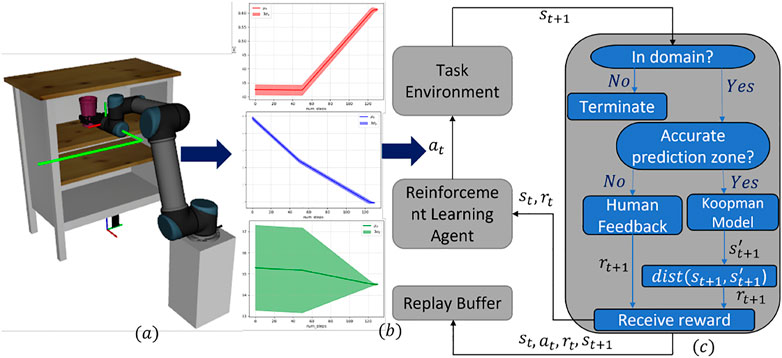
FIGURE 1. Koopman operator–based knowledge-guided RL framework: (A) A simulated UR5 robot is executing a demonstrated trajectory to perform putting a cup in a shelf task. The demonstrated path is shown using a green firm line. (B) Mean and standard deviations of the components of the position vectors, i.e., x, y, z, of all the way points in the demonstrated trajectories. (C) Schematic diagram of the training loop of the RL agent using the proposed methodology.
Furthermore, to facilitate the DRL agent to explore regions where no demonstrated data are present or the Koopman model's stated predictions are inaccurate, a provision is made to accept human feedback in such states in the proposed learning framework. We assume that the human feedback is always optimal, and the human expert knows what the optimal state is at any stage of the learning phase of the DRL agent. We have used human feedback in terms of a fixed numeric positive reward value for being at the right state (Griffith et al., 2013), otherwise a fixed negative reward is received. This simple pair of human reward values will reduce the effort of the human expert. Furthermore, we chose numeric rewards as human feedback, as they are relatively easier to provide by a human expert instead of providing a correct state or action feedback. Since the DRL agent only queries for the human feedback when there is no demonstrated data or when the Koopman model of human intent is inaccurate, the number of queries is significantly lesser than the feedback asked for after every iteration Christiano et al. (2017).
We have presented two examples of learning human preferred trajectories using the proposed algorithm which resulted in successful learning of the expert's trajectories. The second example also signifies the potential of using the proposed learning algorithm in achieving human preferred trajectories where safety of the nearby human is essential.
Our key contribution in this article is the modeling of the human intent using the Koopman operator theory and making use of that intent model to design the reward function for an autonomous planning agent which is an RL agent. Furthermore, human demonstrated trajectories are utilized to obtain a trust domain within which the Koopman model's predictions are considered. Also, the proposed algorithm asks for human feedback occasionally, and the human expert has to provide a fixed positive or negative reward which is relatively less cumbersome than other feedback mechanisms used in the RL literature. For details, please see Wirth et al. (2017) and the references therein. The efficacy of the proposed RL algorithm is demonstrated with two examples. In both the examples, the proposed algorithm is utilized to learn human demonstrated trajectories to the six degrees of freedom of a universal robot. It is shown that the Koopman operator–based reward function for the RL agents can effectively learn the human expert's trajectories in situations where the motions of the robot end-effector are geometrically constrained (please see the example in Section 5.1). In the second example, the proposed algorithm is utilized to learn a human demonstrated path where the safety of the human subject in the surroundings takes priority. Finally, we have presented a modified DQN learning framework with a Koopman model of human intent. We have chosen DQN agent to leverage the simplicity of the algorithm such that the new modifications are incorporated in it easily. We could have used any other reward-based RL algorithms and our proposed modifications would have been equally valid.
The proposed learning method can be treated as an alternative approach to the inverse reinforcement learning (IRL) and generative adversarial imitation learning (GAIL) for imitation learning problems. Unlike IRL and GAIL, our method does not need a reward function to be learned, instead we show that a fixed set of reward values can be used to learn from the demonstrated trajectories with some simple modifications in the DQN algorithm.
The article is organized as follows. The next section provides the works related to the algorithm presented in this article. In Section 3, we state the problem mathematically and propose knowledge-guided DQN with the Koopman operator-based reward function. In Section 4, we describe the proposed methodology in algorithm format. Section 5 presents two case studies with learning from human preferred trajectories using the proposed algorithm. Finally, we conclude the work in Section 6 with the discussion on the potential direction to pursue this work in the future.
2 Related Work
To plan motion for robotic arms using any learning techniques, the main objective is to identify the right action given the observations of the robots' states and their surrounding environment. In many robotic applications, the planning agent is desired to take actions that a human expert would take, given the same observations. This leaning paradigm is known as imitation learning (IL). For any realistic robotic tasks, the size of the observation space becomes large and learning to take human preferred actions in that observation space becomes an overly challenging task. However, it has been proved by the researchers that incorporation of human demonstrations in the learning algorithm is not only effective but also helpful in reducing the learning time (Bakker and Kuniyoshi, 1996; Schaal et al., 1997; Schaal, 1999; Billard and Matarić, 2001).
Traditionally in IL, the demonstrated trajectories are used as data points consisting of state–action pairs to train a deep neural network-based agent with the assumption that each data point comes from a Markov decision process (MDP) (Ross and Bagnell, 2010; Ross et al., 2011). The problem with Ross et al. (2011) is that the agent only learns how to mimic experts' behavior but fails to take the right actions where no demonstrated data are present and cannot learn a better policy than the experts. Essentially, Ross et al. (2011) does not consider the cost of making a right or wrong action. In Ross and Bagnell (2014), an RL perspective of the IL has been introduced by considering the cost (cost-to-go) of an action from a given state as a Q(s, a) value to the RL algorithm. Hester et al. (2018) used deep Q learning to learn from small sets of demonstrations by combining temporal difference updates with supervised classification of the demonstrators' actions. The work in Hester et al. (2018) assumes that the demonstration data provide both states and actions which are true in many gaming environments, but when a human demonstrates for a robot, he/she only provides the states as end-effector pose, and no direct actions are provided. It further assumes that the demonstrated data are noise free, hence they completely represent the expert's behavior. Furthermore, unlike gaming environments, while working with real robots, there is no reward function that is defined which is essential for the success of the RL algorithms.
Behavioral cloning from observation (BCO) (Torabi et al., 2018) considers only the states as the experts' demonstration, and the corresponding underlying actions are inferred from a learned dynamics model of the robot and then IL is performed with the states and recovered actions. A linear regression model is developed using the collected data from a human prosthesis device that represents a knowledge base, which is then used to guide a Q-learning process in Gao et al. (2020). However, a linear regression model of the state–action pair over the entire demonstration domain can limit the use of the underlying knowledge.
In IL, the field of active learning allows the learning agent to query the human expert for optimal state/action from a given state where there is no demonstration data, and this is used to improve the current policy. This technique has been proved to be data efficient and learns the optimal policy quicker. In these approaches, the learned agent executes the policy and asks for new samples from the human in places where the agent does not feel confident Chernova and Veloso (2008). In Jin et al. (2020), a parametric reward function that is a representative of the experts' intention is learnt from the sparsely demonstrated way points. However, the way points are given with respect to a certain time instance and selection of such way points also impacts the success in learning the parametric reward function.
Success of the RL algorithms is vastly dependent on the reward function. However, in many situations the appropriate reward function is unknown to the agent or may be partially known. In inverse RL (IRL) (Ng and Russell, 2000; Ziebart et al., 2008), the reward function is developed simultaneously with the learning process with the agent. Although IRL methods have been proven to be effective in learning reward functions for a variety of the problems, they are computationally heavy and need a huge number of iterations before the learning processes are completed. Further use of IRL to learning control policy from the human demonstrations with unknown robot dynamics can be found in Finn et al. (2016).
The work in this article is targeted toward designing a simple but effective reward function for the RL algorithms to learn paths from human demonstrations. In this context, we have developed the Koopman operator-based human knowledge representation from human demonstrated trajectories. Unlike IRL techniques, our reward function does not change during the learning process, which makes the DRL agent to learn faster for certain kinds of robotics tasks as presented in Section 5. Furthermore, the demonstrated trajectories required for the proposed algorithm merely contain the end-effector poses and the learning agent recovers the underlying correct actions if the kinematics of the robot is known. A similar approach has also been used by Niekum et al. (2015). Furthermore, unlike in Gao et al. (2020) where human knowledge has been developed using a linear regression model, in our work the use of the Koopman operator to develop human knowledge representation can accommodate nonlinearity in the human intent model. Our work is partially related to the idea of using DQN for IL as introduced in Hester et al. (2018). However, we have designed a task-specific reward function using the Koopman theory without assuming that a reward function is available to the learning agent. While in Hester et al. (2018), the reward function was assumed to be given. Soft Q imitation learning (SQIL) has been proposed in Reddy et al. (2019) where it is shown that a simple Q learning–based agent with fixed-type reward values can be used to solve IL which outperformed GAIL. Our proposed method also uses fixed reward type of reward values, but as to which fixed reward value the agent would receive is decided by the Koopman operator–based human intent model's prediction. We characterize our proposed method as an alternative to Reddy et al. (2019) and further confirm the idea that simple Q learning with a fixed type of reward can be used for IL problems. Furthermore, Abraham et al. (2017) and Broad et al. (2020) used the Koopman theory to obtain a data-driven linearized model of a system, which was then used to obtain a model-based controller. However, our work uses the Koopman theory to obtain human intent model from the demonstrated trajectories to predict the human preferred state from a state where the RL agent arrived during exploration of the environment.
3 Knowledge-Guided Reinforcement Learning
In this article, we are interested in developing a knowledge-guided RL algorithm to obtain polices by learning from the state-only observation sequences to accomplish a specific task. Our goal is to utilize the demonstrated state observation sequences as a knowledge base, which we further use to predict the desired state of the learning agent as compared to the actual state that the agent has arrived at after taking an action to decide the reward value that the agent would receive for that action.
Let us first define some of the notations that we will be using throughout the article. We denote the state observation sequences or trajectories as a set
3.1 Deep Q Network as Learning Agent
We pose the IL problem as an MDP which is represented by a 5-tuple
Then, an optimal policy π∗ is defined as
A deep Q network approximates Q-function with a neural network. In this article, we particularly used double DQN (Van Hasselt et al., 2016), where a target network is used to find the loss between the current and desired prediction of the Q values. This loss is then used to update the weights of the neural network representing the agent. The squared loss of the double DQN is defined as follows:
In the case of DQN with experience replay, all the experiences (state, action, and reward) while exploring different actions are stored in a buffer storage and a batch (collection of the stored experiences) is selected by randomly sampling experiences from the buffer to train the deep Q network. Furthermore, human demonstrated trajectories are used to obtain a model of human expert's intention. In this article, we have proposed the Koopman operator–based human knowledge representation. The knowledge representation is a statistical function, say
3.2 Koopman Operator–Based Human Knowledge Representation
The Koopman operator (Henrion et al., 2016) has been traditionally a data-driven method used to obtain a linear model of a nonlinear dynamic system. Let us consider a discrete-time dynamical system as
where f(⋅) is a nonlinear function and
Please note that, in general, the function g(⋅) is unknown. However, there are several data-driven (Lusch et al., 2018) and model-based (Abraham et al., 2017) techniques to approximate g(⋅). Unless g(⋅) is an infinite dimensional vector, there will be an approximation error or residual error. Using the residual error as re, the approximate linear dynamics in finite dimensional lifted space is described as
We are interested in finding K such that the value of re is minimum. In this research, we have adopted the least-square method to compute K as given by Williams et al. (2015).
Suppose, we are given M data points of one trajectory or multiple trajectories (not necessarily in order), then the total residual due to linear approximation is obtained as
Then, the least-square optimization problem can be formulated as
where K* is the optimal K for which the residual R will be minimum. It can be shown that the least square solution of the optimization problem in Eq. 9 will be (Abraham and Murphey, 2019)
where the operator † represents pseudo-inverse of a matrix and
3.3 Designing Reward Function for the Deep Q-Learning Agent
In this work, we have used the Koopman operator to represent human knowledge base. More specifically, we have identified the Koopman operator Kp based on human demonstrated trajectories such that the given current end-effector state st and the human preferred end-effector state can be obtained as
where g is the same as defined in Eq. 6 and g−1(⋅) is the inverse transformation of g(⋅). Once the desired end-effector pose
where ‖ ⋅‖2 represents 2-norm of a vector. Another advantage of using the Koopman operator to represent human knowledge base is that if at any step the DRL agent takes a wrong action from a given state, it can step back and explore the other possible actions from that state and compare the resulting state with the state suggested by the knowledge base. The agent can then know from that state what are the right and wrong actions to take and can store both these experiences to utilize them during experience replay.
3.4 Trust Domain for the Koopman Prediction
In RL, appropriate reward signal plays an important role in the success of the learning process. In our case, this is hinged at the correct prediction of the human intended state of the agent
Let us denote
4 Koopman Operator–Based Knowledge-Guided Learning Method
The outline of the training loop is visualized in Figure 1C, which represents a typical training loop for a DQN agent with an improved reward function block on the right-hand side of the figure. At the top of the reward function block is a decision-making block named indomain, which takes the agent's state after executing an action, i.e., st+1 as input, and checks whether that state lies in the trusted domain of the Koopman prediction domain. If that block returns true, then the Koopman operator–based human intent model predicts the state for step t + 1, i.e.,
In Algorithm 1, we present the pseudo-code for the proposed Koopman Operator–Based Knowledge-Guided DQN for the ease of implementation. Algorithm 1 follows the basic outline of the DQN architecture but has been improvised into learning to imitate human intended trajectories with a newly introduced reward function using the Koopman theory. The added functionalities are highlighted as blue texts. Please note, in Algorithm 1, the method getTrustDomain simply follows the equations described in Section 3.4. The indomain method is equivalent to the indomain block in Figure 1C, as already discussed. Furthermore, the method getHumanFeedback invokes a query to the human expert for a feedback in terms of positive or negative rewards. The env.humanIntentModel implements Eq. 13. Finally, the dist method is equivalent to the dist block of Figure 1C, which has been discussed previously. Table 1 shows the elements of the discrete action space considered in this article.
5 Case Study
In this section, we provide two examples to demonstrate the utility of the proposed algorithm. The first example pertains to learning to execute putting object in shelf task with a universal robot (UR5 arm) from the human demonstration. The path planning for this kind of task is challenging with traditional motion planners since the motion of the end-effector is constrained to lie only in
5.1 Learning to Plan to Put an Object in Shelf
In this example, the proposed Algorithm 1 is utilized to plan a path for putting an object into a shelf using an UR5 robot. Even for this seemingly simple task, the planning problem is challenging because of the constrained motion of the robot end-effector. More specifically, throughout the path, the end-effector's orientations are kept fixed and only the positions are changed. The learning agent has to recover that information to plan a path using the reward feedback from the human intent model developed using the demonstrated trajectories. The learning agent was successful in learning to plan a path for the task. Figure 2 shows an instance of the initial and goal end-effector poses and one of the demonstrated trajectories for this task. The distributions of the individual components of the states considering all the demonstrated trajectories are presented in the Figure 3.
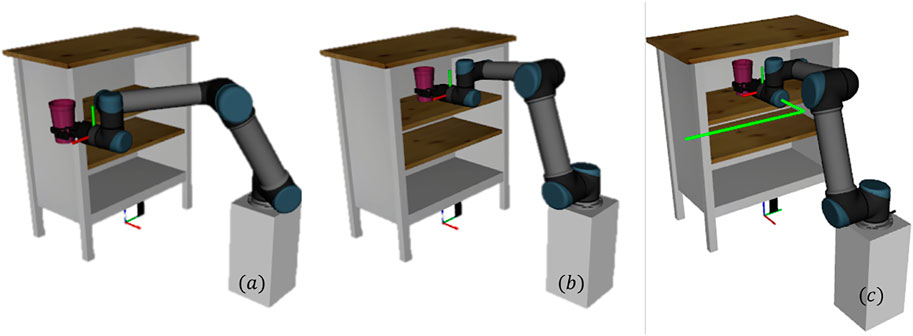
FIGURE 2. Planning to put an object in a shelf. Left: initial pose of the arm. Middle: goal pose of the arm. Right: one of the demonstrated path for putting the object in the shelf task.

FIGURE 3. Means and three standard deviations of the x (left), y (middle), and z (right) values of the demonstrated trajectories.
Since for this particular task, the orientation of the end-effector was kept fixed, the Koopman operator–based human intent model is required only to predict the experts' end-effector position. For any action taken by the learning agent that changes the end-effector's orientation, a negative reward is provided to the learning agent. For this reason, given the end-effector poses from the demonstrated trajectories data, we extracted the position vectors
The left panel of Figure 4 shows the accuracy of the trained Koopman operator to predict human preferred state
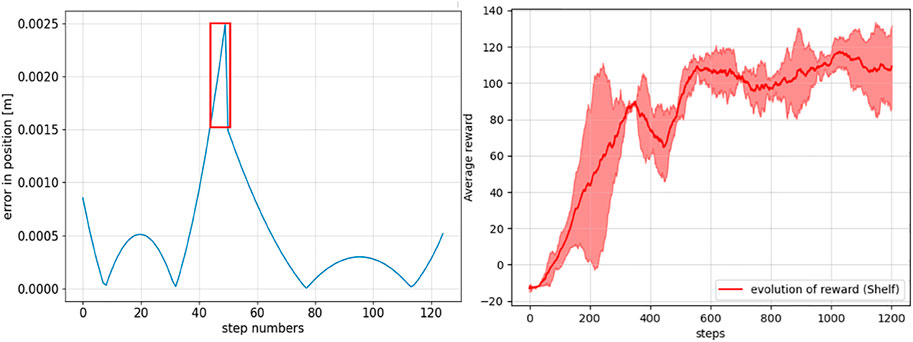
FIGURE 4. Left: absolute prediction error between the ground truth and the Koopman operator–based human intent model predicted end-effector positions at different steps. The region with a higher prediction error is marked as a red box where human intervention to provide reward is preferred. Right: evolution of the episodic cumulative rewards averaged over 100 episodes.
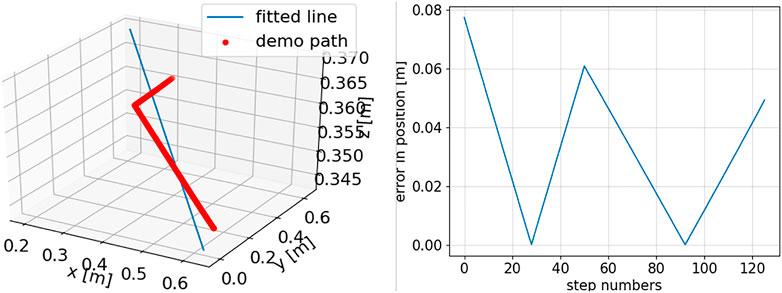
FIGURE 5. For one demonstrated trajectory: left, line approximation of the position data by minimizing the least square errors; right, line approximation errors at the different steps of the demonstrated trajectory.
5.2 Learning to Safely Transfer Knife in the Close Approximation of Human
The objective of this example is to utilize Algorithm 1 to make the DQN agent learn to transfer a sharp object (e.g., a knife) safely while a human being is in close proximity of an UR5 robot. The initial pose of the robot is such that the sharp edge of the knife is held upward which is an unsafe pose to deliver the object to a human being (see left panel of Figure 6). Ideally, the knife should be transferred in such a way such that the sharp edge is brought down as quickly as possible before transferring the sharp-edged object to the human. Also, at the goal pose when the knife reaches in front of the human, the sharp edge should be completely in the downward direction. The left panel of Figure 6 shows the initial, goal, and some of the intermediate poses of the end-effector for one of the demonstrated trajectories. This task is particularly interesting because throughout the path, both the position and orientation of the end-effector change during the execution of the task while the rotational distance to the goal is minimized faster than that of the positional distance. The changes in position and orientation distances from the start to the goal pose, are shown in the right panel of Figure 6, respectively. It can be noted that throughout the steps of the demonstrated path, the position distance was reduced at the same rate, whereas the orientation distance was reduced at a higher rate in the initial steps and at a lower rate afterward to ensure the knife edge is brought downward rapidly before passing it to the human.
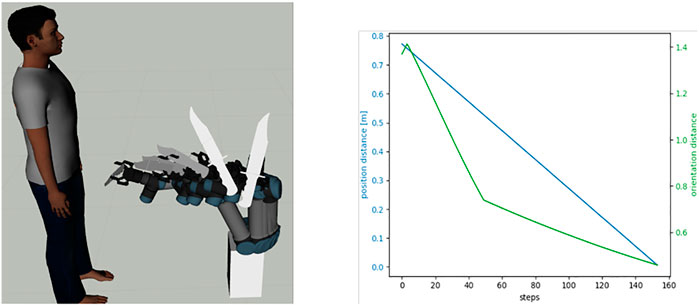
FIGURE 6. Left, the robot executing one of the demonstrated trajectories for transferring a knife safely to a human. Right: characteristic of the change of the positional (blue) and orientational (green) distance to the goal at different steps of one of the demonstrated paths.
In this example, the planning agent has to learn the expert's trajectory where the end-effector's position and orientation both change and at different rates at different segments of the trajectory. The span of the demonstrated trajectories used to obtain the human knowledge representation using the Koopman operator is shown in Figures 7, 8, respectively. Furthermore, since in this task, both the position and orientation of the robot's end-effector change, the Koopman operator–based human intent model is characterized by two matrices Kp and Ko, such that
where

FIGURE 7. Means and three standard deviations of the x (left), y (middle), and z (right) values of the demonstrated trajectories.

FIGURE 8. Means and three standard deviations of the roll (left), pitch (middle), and yaw (right) values of the demonstrated trajectories.
In order to obtain Kp and Ko, we have used Eq. 10 with
Once the matrices Kp and Ko are identified, for any given position and orientation vectors of the learning agent at time step t, the human preferred states can be predicted using Eqs. 17, 18, respectively. To test the performance of the learned human intent model, we took the states of one of the demonstrated trajectories and predicted the next position and orientation states using Kp and Ko, respectively. This trajectory was not used while identifying Kp and Ko. We found that the maximum predicted position error was in the order of submillimeters and did not vary much for different steps. However, the prediction errors of the orientation states varied over the step as shown in the left panel of Figure 9.
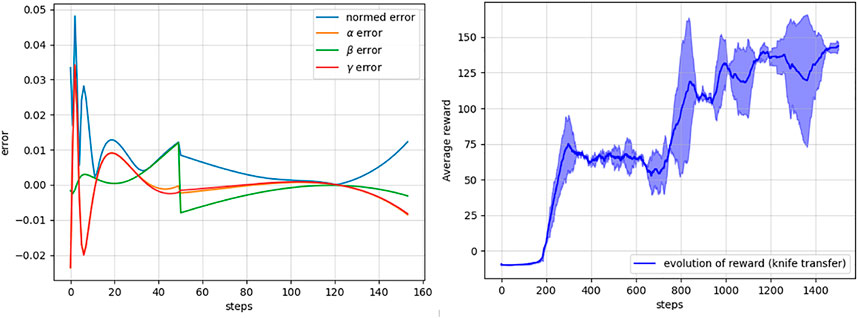
FIGURE 9. Left: prediction errors of the learned Koopman operator for the orientation elements, α, β, γ, or roll, pitch, and yaw elements with respect to the ground truth over different steps. Right: mean and standard deviation of the cumulative rewards over the episodes during the training of the DRL agent for the knife transfer task obtained with multiple trial runs of the learning task.
In the right panel of Figure 9, we present the evolution of the accumulated reward of the DQN agent while learning the task using the proposed Algorithm 1. The learning agent took
6 Conclusion
In this article, we have proposed a novel knowledge-guided RL framework for arm-type robots to learn from expert demonstrated trajectories. This is achieved by developing a human intent model based on the Koopman operator theory utilizing the data from the human demonstrated trajectories. This Koopman operator–based human intent model is then used to shape a reward function for a DQN agent which should act as an autonomous planner upon successful training. Furthermore, we have used the span of the coordinates of the poses of the demonstrated trajectories to help the learning agent to decide whether to rely on the Koopman operator–based human knowledge representation prediction or not such that the agent does not receive a spurious reward during its learning stage which would otherwise hinder the learning process. We have presented two examples that utilize our proposed Koopman operator–based knowledge-guided RL algorithm to learn the tasks satisfying human intent. The second task not only shows the efficacy of the proposed algorithm but also demonstrates how the algorithm can be used to add safety measures in performing a task while humans are in close proximity.
This work paves the way for many future research directions to be pursued. In this work, we have considered a discrete action space which is a limitation that we want to work on in the future to make the algorithm work in more general settings by utilizing the continuous action space. Furthermore, we have assumed that there are no obstacles around the robots' workspace. It would be interesting to extend this work to environments with obstacles.
Data Availability Statement
The raw data supporting the conclusions of this article will be made available by the authors, without undue reservation.
Author Contributions
AS and YW contributed to conception and design of the study. AS conducted the experiments and wrote the first draft of the manuscript. YW contributed to manuscript revision, and read and approved the submitted version.
Funding
This work is supported by the National Science Foundation under Grant CMMI-1454139.
Conflict of Interest
The authors declare that the research was conducted in the absence of any commercial or financial relationships that could be construed as a potential conflict of interest.
Publisher’s Note
All claims expressed in this article are solely those of the authors and do not necessarily represent those of their affiliated organizations, or those of the publisher, the editors, and the reviewers. Any product that may be evaluated in this article, or claim that may be made by its manufacturer, is not guaranteed or endorsed by the publisher.
References
Abraham, I., De La Torre, G., and Murphey, T. D. (2017). “Model-based Control Using Koopman Operators,” in 2017 Robotics: Science and Systems, RSS 2017 (MIT Press Journals). doi:10.15607/rss.2017.xiii.052
Abraham, I., and Murphey, T. D. (2019). Active Learning of Dynamics for Data-Driven Control Using Koopman Operators. IEEE Trans. Robot. 35, 1071–1083. doi:10.1109/tro.2019.2923880
Bakker, P., and Kuniyoshi, Y. (1996). “Robot See, Robot Do: An Overview of Robot Imitation,” in AISB96 Workshop on Learning in Robots and Animals (Springer), 3–11.
Billard, A., and Matarić, M. J. (2001). Learning Human Arm Movements by Imitation:. Robotics Aut. Syst. 37, 145–160. doi:10.1016/s0921-8890(01)00155-5
Broad, A., Abraham, I., Murphey, T., and Argall, B. (2020). Data-driven Koopman Operators for Model-Based Shared Control of Human-Machine Systems. Int. J. Robotics Res. 39, 1178–1195. doi:10.1177/0278364920921935
Chernova, S., and Veloso, M. (2008). “Teaching Collaborative Multi-Robot Tasks through Demonstration,” in Humanoids 2008-8th IEEE-RAS International Conference on Humanoid Robots (IEEE), 385–390. doi:10.1109/ichr.2008.4755982
Christiano, P., Leike, J., Brown, T. B., Martic, M., Legg, S., and Amodei, D. (2017). Deep Reinforcement Learning from Human Preferences. arXiv preprint arXiv:1706.03741.
Finn, C., Levine, S., and Abbeel, P. (2016). “Guided Cost Learning: Deep Inverse Optimal Control via Policy Optimization,” in International Conference on Machine Learning (Berkeley, Berkeley, USA: University of California), 49–58.
Gao, X., Si, J., Wen, Y., Li, M., and Huang, H. H. (2020). “Knowledge-guided Reinforcement Learning Control for Robotic Lower Limb Prosthesis,” in 2020 IEEE International Conference on Robotics and Automation (ICRA) (IEEE), 754–760. doi:10.1109/icra40945.2020.9196749
Griffith, S., Subramanian, K., Scholz, J., Isbell, C. L., and Thomaz, A. L. (2013). Policy Shaping: Integrating Human Feedback with Reinforcement Learning. Georgia Institute of Technology.
Hester, T., Vecerik, M., Pietquin, O., Lanctot, M., Schaul, T., Piot, B., et al. (2018). “Deep Q-Learning from Demonstrations,” in Proceedings of the AAAI Conference on Artificial Intelligence (AAAI).
Jin, W., Murphey, T. D., Kulić, D., Ezer, N., and Mou, S. (2020). Learning from Sparse Demonstrations. arXiv preprint arXiv:2008.02159.
Lusch, B., Kutz, J. N., and Brunton, S. L. (2018). Deep Learning for Universal Linear Embeddings of Nonlinear Dynamics. Nat. Commun. 9 (1), 1–10. doi:10.1038/s41467-018-07210-0
Niekum, S., Osentoski, S., Konidaris, G., Chitta, S., Marthi, B., and Barto, A. G. (2015). Learning Grounded Finite-State Representations from Unstructured Demonstrations. Int. J. Robotics Res. 34, 131–157. doi:10.1177/0278364914554471
Reddy, S., Dragan, A. D., and Levine, S. (2019). Sqil: Imitation Learning via Reinforcement Learning with Sparse Rewards. arXiv preprint arXiv:1905.11108.
Ross, S., and Bagnell, D. (2010). “Efficient Reductions for Imitation Learning,” in Proceedings of the Thirteenth International Conference on Artificial Intelligence and Statistics (JMLR Workshop and Conference Proceedings), 661–668.
Ross, S., and Bagnell, J. A. (2014). Reinforcement and Imitation Learning via Interactive No-Regret Learning. arXiv preprint arXiv:1406.5979.
Ross, S., Gordon, G., and Bagnell, D. (2011). “A Reduction of Imitation Learning and Structured Prediction to No-Regret Online Learning,” in Proceedings of the Fourteenth International Conference on Artificial Intelligence and Statistics (JMLR Workshop and Conference Proceedings), 627–635.
Schaal, S., et al. (1997). Learning from Demonstration. Adv. neural Inf. Process. Syst. 1, 1040–1046.
Schaal, S. (1999). Is Imitation Learning the Route to Humanoid Robots? Trends cognitive Sci. 3, 233–242. doi:10.1016/s1364-6613(99)01327-3
Sinha, A., Sarker, A., and Chakraborty, N. (2021). “Task Space Planning with Complementarity Constraint-Based Obstacle Avoidance,” in International Design Engineering Technical Conferences and Computers and Information in Engineering Conference. Vol. Volume 8B: 45th Mechanisms and Robotics Conference (MR) (ASME). doi:10.1115/detc2021-72009
Stilman, M. (2007). “Task Constrained Motion Planning in Robot Joint Space,” in 2007 IEEE/RSJ International Conference on Intelligent Robots and Systems (IEEE), 3074–3081. doi:10.1109/iros.2007.4399305
Torabi, F., Warnell, G., and Stone, P. (2018). Behavioral Cloning from Observation. arXiv preprint arXiv:1805.01954.
Van Hasselt, H., Guez, A., and Silver, D. (2016). “Deep Reinforcement Learning with Double Q-Learning,” in Proceedings of the AAAI Conference on Artificial Intelligence. Vol. 30 (AAAI).
Williams, M. O., Kevrekidis, I. G., and Rowley, C. W. (2015). A Data-Driven Approximation of the Koopman Operator: Extending Dynamic Mode Decomposition. J. Nonlinear Sci. 25, 1307–1346. doi:10.1007/s00332-015-9258-5
Wirth, C., Akrour, R., Neumann, G., and Fürnkranz, J. (2017). A Survey of Preference-Based Reinforcement Learning Methods. J. Mach. Learn. Res. 18, 1–46.
7 Appendix
7.1 Deep Q-Learning Structure
The learning agent and target agent both have the same structure with two hidden layers each having 1,024 units of neurons for the putting object in shelf task (task 1) or 1,560 units for knife transfer task (task 2) and relu activation for both task 1 and task 2. In the current implementation, the agent can observe the full end-effector pose and its distance to the goal, both in position and orientation spaces. Hence, the dimension of the observed state is 8 (pose: 6, position distance to goal: 1, and orientation distance to goal: 1). The input layer for task 1 has the dimension 5 (3 for position coordinates and 2 for the position and orientation distances). For task 2, the dimension of the input layer is 8 (3 for position coordinates, 3 for rotation coordinates, and 2 for position and orientation distances). The output of the DQN has the same dimension as that of the size of the action space which is 10 for both of the tasks considered in this article. Each element of the output vector represents the Q value of the state–action pair. The neural network is compiled with ADAM optimizer and MSE loss. We have used TensorFlow version 2.7 to model the neural network.
7.2 Hyper-Parameters
Keywords: deep reinforcement learning (DRL), deep Q network (DQN), Koopman operator, learning from demonstration, human knowledge representation
Citation: Sinha A and Wang Y (2022) Koopman Operator–Based Knowledge-Guided Reinforcement Learning for Safe Human–Robot Interaction. Front. Robot. AI 9:779194. doi: 10.3389/frobt.2022.779194
Received: 18 September 2021; Accepted: 29 April 2022;
Published: 16 June 2022.
Edited by:
Rushikesh Kamalapurkar, Oklahoma State University, United StatesReviewed by:
Joel Rosenfeld, University of South Florida, United StatesHe Bai, Oklahoma State University, United States
Copyright © 2022 Sinha and Wang. This is an open-access article distributed under the terms of the Creative Commons Attribution License (CC BY). The use, distribution or reproduction in other forums is permitted, provided the original author(s) and the copyright owner(s) are credited and that the original publication in this journal is cited, in accordance with accepted academic practice. No use, distribution or reproduction is permitted which does not comply with these terms.
*Correspondence: Yue Wang, yue6@g.clemson.edu
 Anirban Sinha
Anirban Sinha Yue Wang
Yue Wang